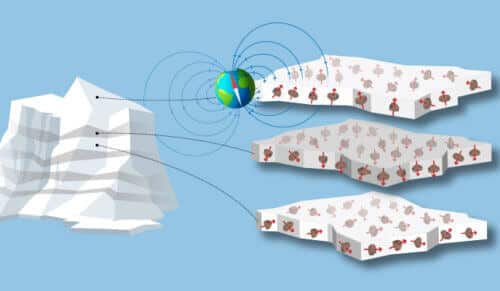Is it possible to reconstruct the Earth's magnetic history using glacier samples?

The history of our planet is recorded, among other things, in the many reversals of its magnetic poles. Weizmann Institute of Science scientists offer a new way to read this historical record: on ice. Their findings, recently published in the scientific journal Earth and Planetary Science Letters, may lead to an improvement in the study of ice core samples taken from glaciers at the Earth's poles, and in the future may even help in understanding the magnetic history of other celestial bodies in our solar system, including Mars and Jupiter's moon , Europe.
The idea of the possible connection between ice and magnetic history was born far from the ice surfaces of the Earth - on the sunny island of Corsica, where Prof. Oded Aharonson, from the Department of Earth and Planetary Sciences, participated in a conference on magnetism. More precisely, the conference participants discussed the field known as paleomagnetism - the study of magnetic minerals trapped in rocks or on the ocean floor; The magnetic direction embedded in these minerals when they were captured can teach about the magnetic field that prevailed in the earth at that time. These magnetic pole reversals occur at random intervals throughout the history of our planet as a result of the chaotic movement of molten metals deep in the Earth's core.
"If it is possible to find small amounts of magnetic materials at the bottom of the ocean, perhaps it is also possible to locate them - and measure them - in the ice", Prof. Aaronson said to himself during the conference. Some of the ice trapped in the Greenland or Alaska glaciers is thousands of years old, and similar to tree rings, these ice layers are stratified according to the periods in which they were formed. Ice cores - long cylinders drilled from the depths of the glaciers - are already used in research today to trace signs of ice ages or warming in the history of the Earth. Why, then, not look for a record of our planet's magnetic pole reversals in these ice layers?
We know that the surface of Mars and large, icy moons like Jupiter's Europa have been exposed to magnetic fields. It will be extremely intriguing to look for reversals in the magnetic field in the ice sampled from these bodies"

In order to answer this question, Prof. Aharonson and research student Yuval Grossman, who led the project, had to first answer the question of whether the Earth's magnetic history is recorded at all in the process of ice formation at the poles. Prof. Aaronson and Grossman hypothesized that it would be possible to find magnetic particles in the ice, originating from the atmospheric dust that served as nuclei around which the snowflakes that fell at the poles were built and became part of the ice layers in the glaciers.
To find out about this matter, the research team set up an experimental set-up that simulates ice formation in the polar glaciers. By finely grinding ice, which is made from purified water, the researchers created artificial snow in the laboratory, added some magnetic dust to it, and let it fall through a cylinder-like structure that was exposed to an external magnetic field that the scientists controlled. Maintaining low temperatures - around 30 degrees Celsius below zero - allowed the research team to produce miniature "ice cores", where the snow and dust froze into hard ice.
"If the dust particles are not affected by an external magnetic field, they are expected to fall out in random directions that cancel each other out," says Prof. Aaronson. "But if some of the dust particles were affected by the external field right next to their freezing, it would be possible to detect the magnetic moment through them."
To measure the magnetism of the ice cores they created in the laboratory, the scientists of the institute brought them to the laboratory of Dr. Ron Shaar at the Hebrew University of Jerusalem, where a highly sensitive magnetometer is installed, capable of measuring even a slight magnetic moment in the ice. The research team discovered a small but present magnetic moment, consistent with the magnetic fields applied to their ice samples.
"Until now, it has been customary to learn about the paleomagnetic history of the Earth through the study of rock layers; In this study, we showed that studying samples of ice cores taken from glaciers may reveal additional dimensions of this history, or help to more accurately date other findings in glaciers", says Prof. Aaronson. "Also, we know that the surface of Mars and large, icy moons like Jupiter's Europa have been exposed to magnetic fields. It will be extremely intriguing to look for reversals in the magnetic field in the ice sampled from these bodies in our solar system." Accordingly, Prof. Aharonson proposed a research project for a future space mission, which will carry out sampling of ice cores on Mars, and he hopes that the current research, which demonstrated the feasibility of measuring magnetic history using ice samples on Earth, will advance the proposed project.
More of the topic in Hayadan:
